The Significance of Intercultural Communication for Workplace Success
VerifiedAdded on 2023/01/18
|9
|2573
|26
Essay
AI Summary
This essay delves into the critical role of intercultural communication in achieving workplace success, drawing upon the author's personal experiences and reflections. It begins by introducing the significance of intercultural business communication and highlights the importance of understanding cultural differences. The main body of the essay analyzes various cultural theories, particularly Hofstede's cultural dimension theory, to explain how culture impacts workplace interactions. It also examines the impact of culture on business operations, including negotiation, marketing, and relationship-building. Furthermore, the essay explores verbal and non-verbal communication styles, including intrapersonal, interpersonal, small group, and public communication, along with the importance of eye contact, gestures, and posture. The conclusion summarizes key findings and outlines an action plan for continuous improvement in intercultural communication skills, emphasizing the importance of curiosity and empathy. The author also acknowledges the progress made in intercultural proficiency and expresses a commitment to further learning and exploration of the subject.
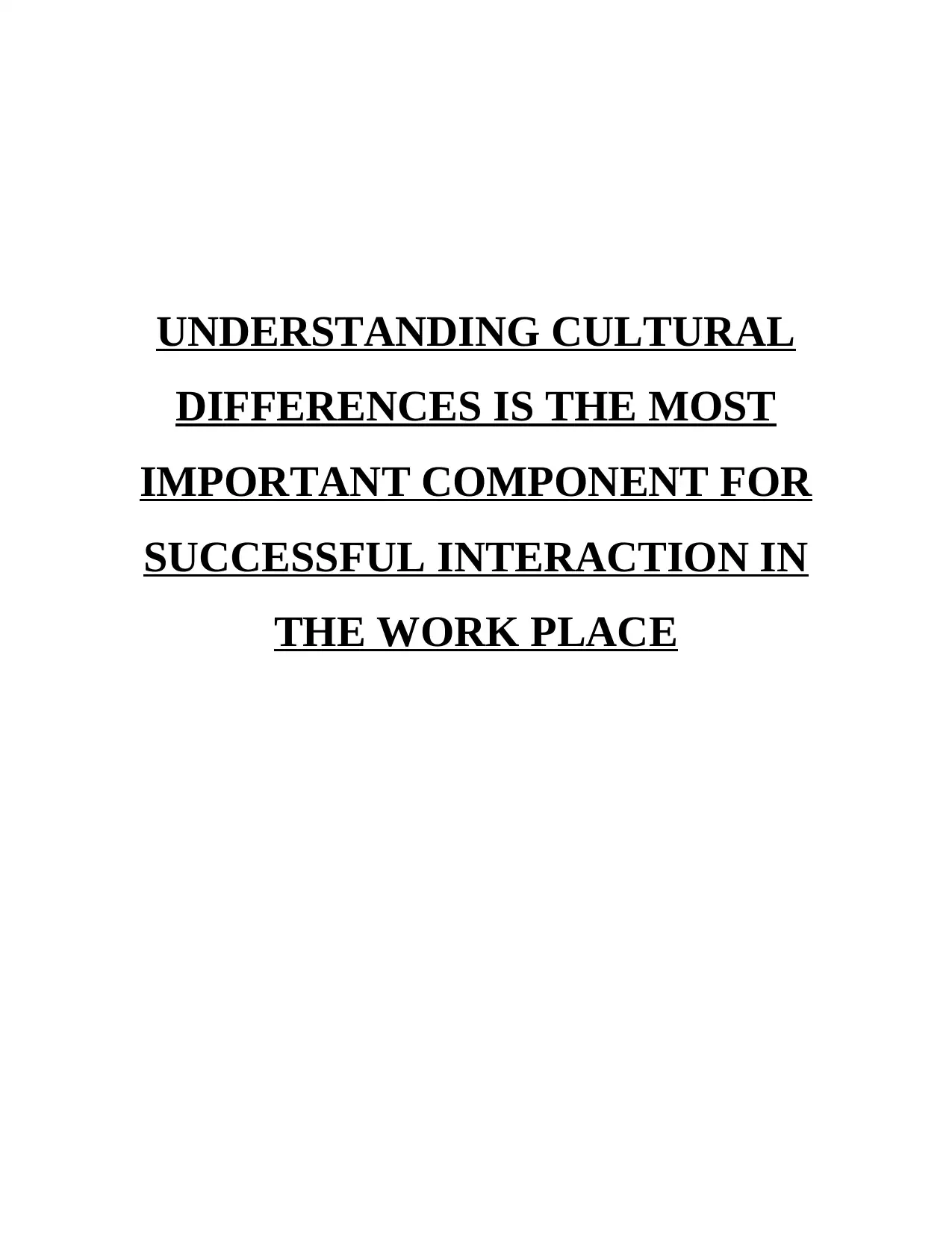
UNDERSTANDING CULTURAL
DIFFERENCES IS THE MOST
IMPORTANT COMPONENT FOR
SUCCESSFUL INTERACTION IN
THE WORK PLACE
DIFFERENCES IS THE MOST
IMPORTANT COMPONENT FOR
SUCCESSFUL INTERACTION IN
THE WORK PLACE
Paraphrase This Document
Need a fresh take? Get an instant paraphrase of this document with our AI Paraphraser
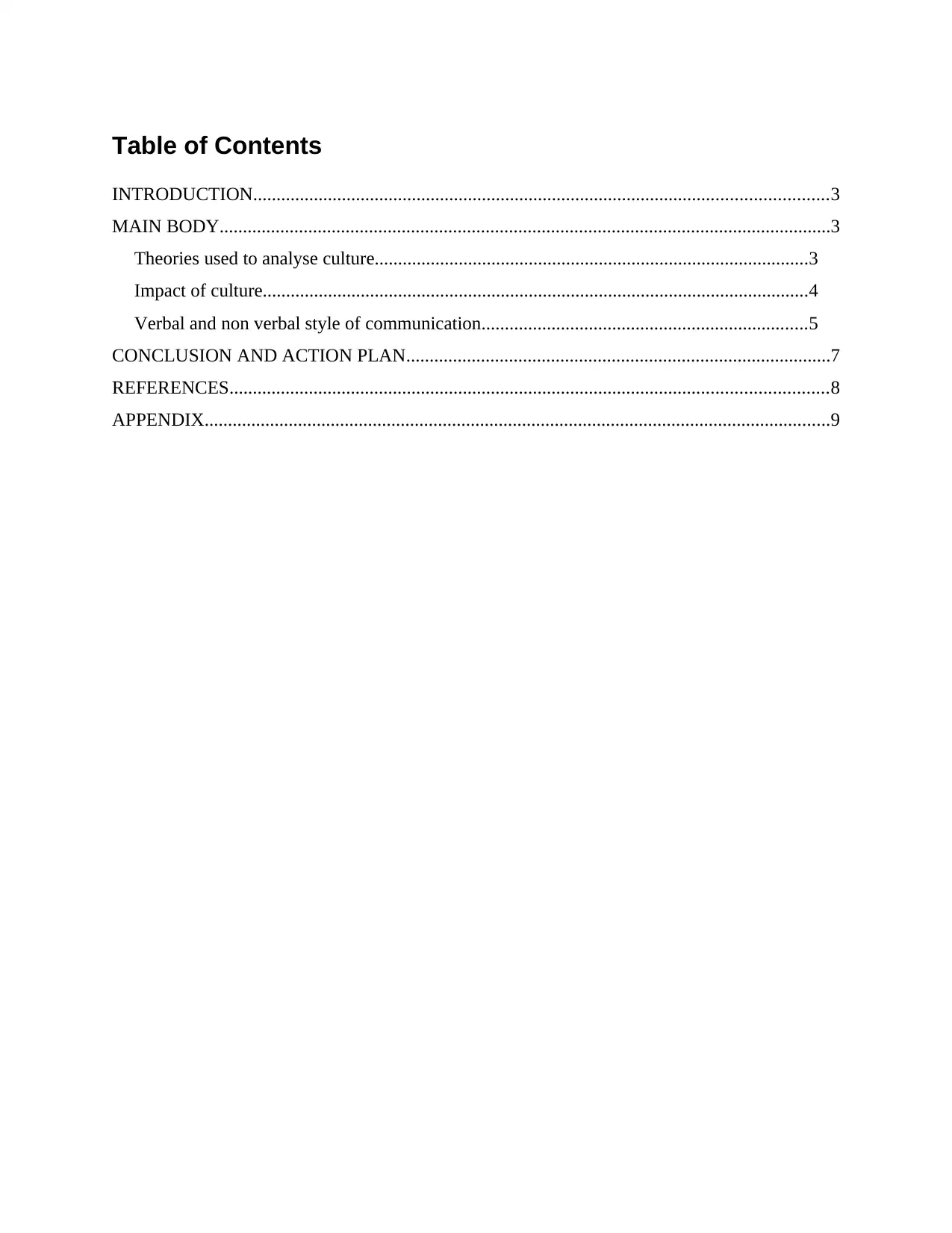
Table of Contents
INTRODUCTION...........................................................................................................................3
MAIN BODY...................................................................................................................................3
Theories used to analyse culture.............................................................................................3
Impact of culture.....................................................................................................................4
Verbal and non verbal style of communication......................................................................5
CONCLUSION AND ACTION PLAN...........................................................................................7
REFERENCES................................................................................................................................8
APPENDIX......................................................................................................................................9
INTRODUCTION...........................................................................................................................3
MAIN BODY...................................................................................................................................3
Theories used to analyse culture.............................................................................................3
Impact of culture.....................................................................................................................4
Verbal and non verbal style of communication......................................................................5
CONCLUSION AND ACTION PLAN...........................................................................................7
REFERENCES................................................................................................................................8
APPENDIX......................................................................................................................................9
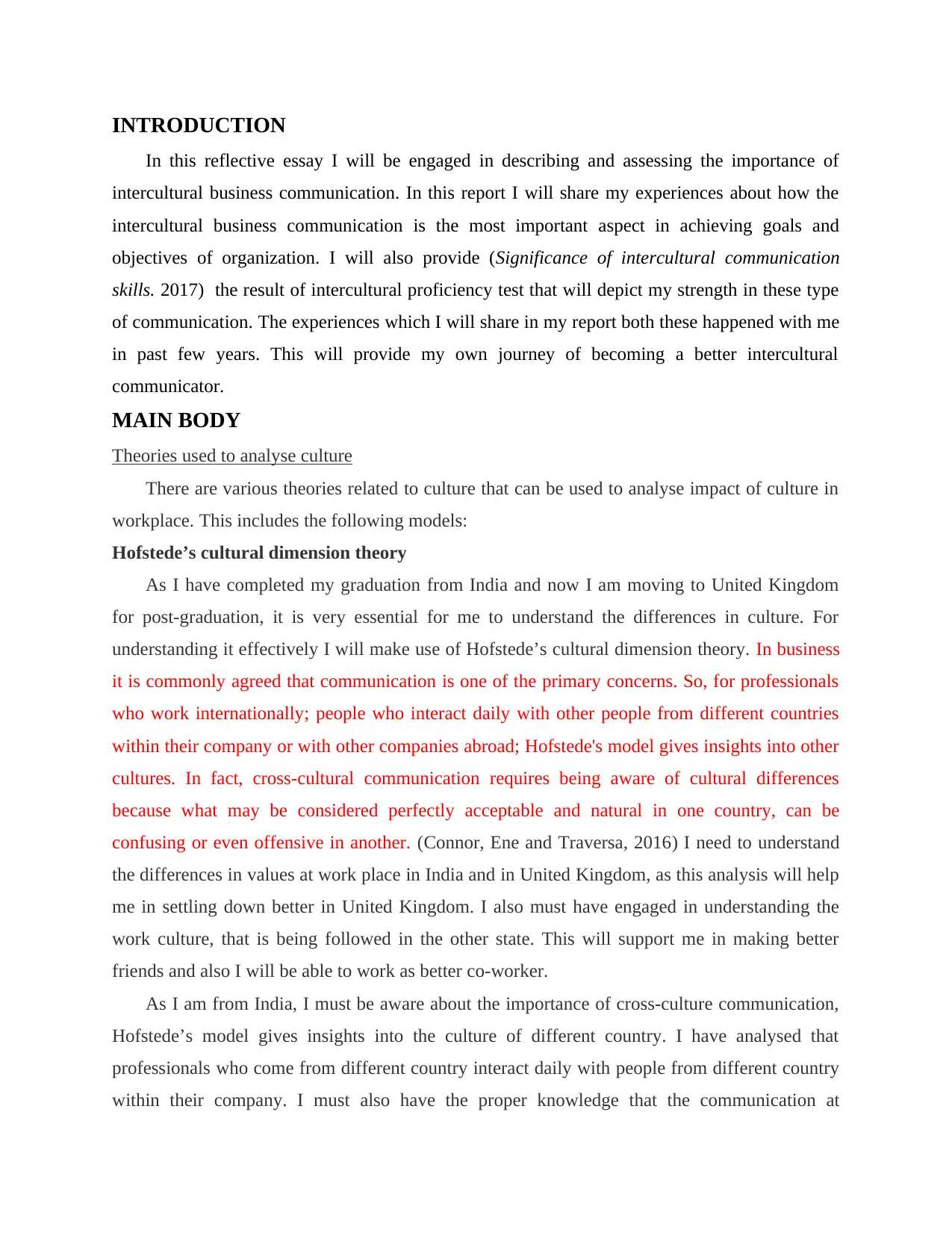
INTRODUCTION
In this reflective essay I will be engaged in describing and assessing the importance of
intercultural business communication. In this report I will share my experiences about how the
intercultural business communication is the most important aspect in achieving goals and
objectives of organization. I will also provide (Significance of intercultural communication
skills. 2017) the result of intercultural proficiency test that will depict my strength in these type
of communication. The experiences which I will share in my report both these happened with me
in past few years. This will provide my own journey of becoming a better intercultural
communicator.
MAIN BODY
Theories used to analyse culture
There are various theories related to culture that can be used to analyse impact of culture in
workplace. This includes the following models:
Hofstede’s cultural dimension theory
As I have completed my graduation from India and now I am moving to United Kingdom
for post-graduation, it is very essential for me to understand the differences in culture. For
understanding it effectively I will make use of Hofstede’s cultural dimension theory. In business
it is commonly agreed that communication is one of the primary concerns. So, for professionals
who work internationally; people who interact daily with other people from different countries
within their company or with other companies abroad; Hofstede's model gives insights into other
cultures. In fact, cross-cultural communication requires being aware of cultural differences
because what may be considered perfectly acceptable and natural in one country, can be
confusing or even offensive in another. (Connor, Ene and Traversa, 2016) I need to understand
the differences in values at work place in India and in United Kingdom, as this analysis will help
me in settling down better in United Kingdom. I also must have engaged in understanding the
work culture, that is being followed in the other state. This will support me in making better
friends and also I will be able to work as better co-worker.
As I am from India, I must be aware about the importance of cross-culture communication,
Hofstede’s model gives insights into the culture of different country. I have analysed that
professionals who come from different country interact daily with people from different country
within their company. I must also have the proper knowledge that the communication at
In this reflective essay I will be engaged in describing and assessing the importance of
intercultural business communication. In this report I will share my experiences about how the
intercultural business communication is the most important aspect in achieving goals and
objectives of organization. I will also provide (Significance of intercultural communication
skills. 2017) the result of intercultural proficiency test that will depict my strength in these type
of communication. The experiences which I will share in my report both these happened with me
in past few years. This will provide my own journey of becoming a better intercultural
communicator.
MAIN BODY
Theories used to analyse culture
There are various theories related to culture that can be used to analyse impact of culture in
workplace. This includes the following models:
Hofstede’s cultural dimension theory
As I have completed my graduation from India and now I am moving to United Kingdom
for post-graduation, it is very essential for me to understand the differences in culture. For
understanding it effectively I will make use of Hofstede’s cultural dimension theory. In business
it is commonly agreed that communication is one of the primary concerns. So, for professionals
who work internationally; people who interact daily with other people from different countries
within their company or with other companies abroad; Hofstede's model gives insights into other
cultures. In fact, cross-cultural communication requires being aware of cultural differences
because what may be considered perfectly acceptable and natural in one country, can be
confusing or even offensive in another. (Connor, Ene and Traversa, 2016) I need to understand
the differences in values at work place in India and in United Kingdom, as this analysis will help
me in settling down better in United Kingdom. I also must have engaged in understanding the
work culture, that is being followed in the other state. This will support me in making better
friends and also I will be able to work as better co-worker.
As I am from India, I must be aware about the importance of cross-culture communication,
Hofstede’s model gives insights into the culture of different country. I have analysed that
professionals who come from different country interact daily with people from different country
within their company. I must also have the proper knowledge that the communication at
⊘ This is a preview!⊘
Do you want full access?
Subscribe today to unlock all pages.

Trusted by 1+ million students worldwide
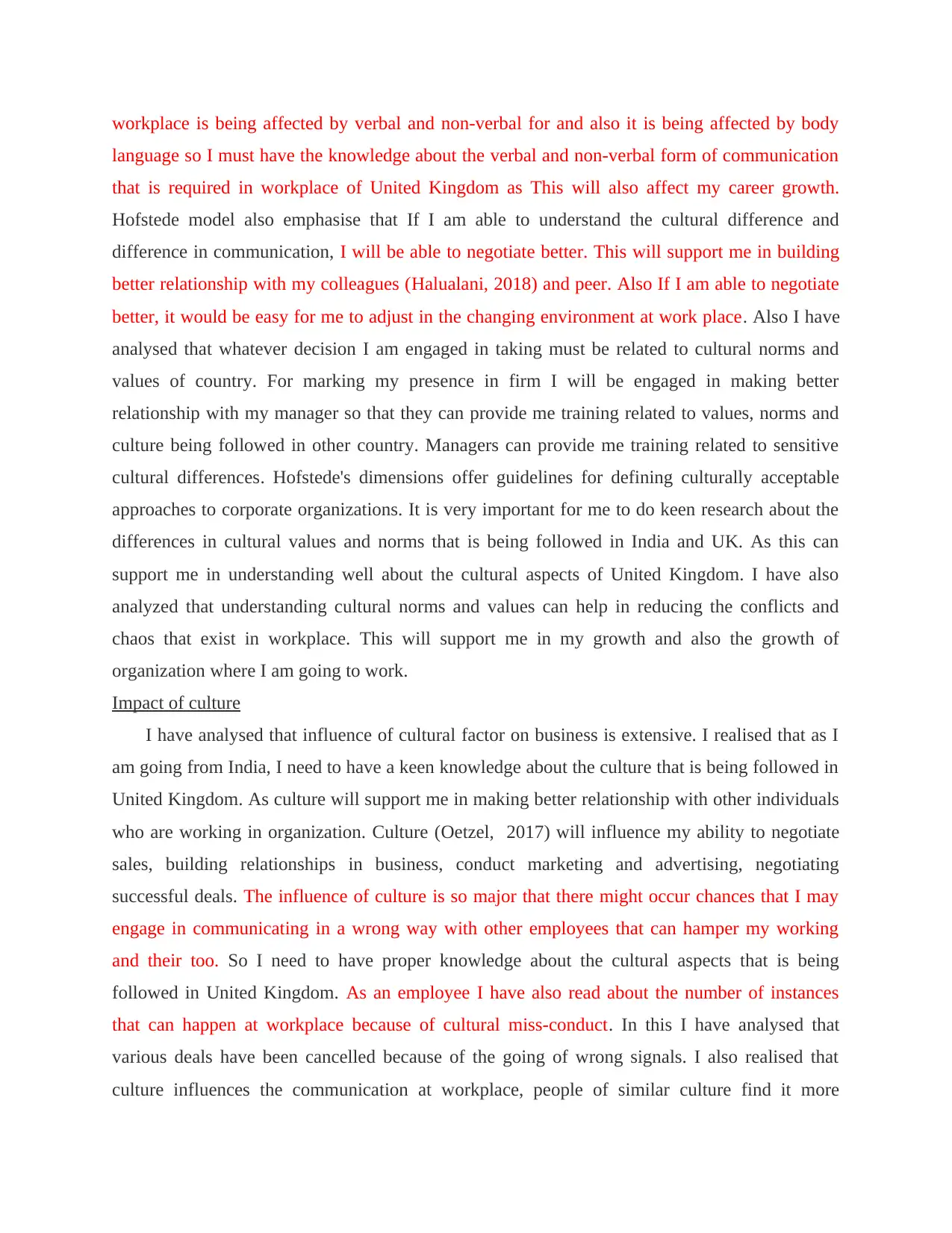
workplace is being affected by verbal and non-verbal for and also it is being affected by body
language so I must have the knowledge about the verbal and non-verbal form of communication
that is required in workplace of United Kingdom as This will also affect my career growth.
Hofstede model also emphasise that If I am able to understand the cultural difference and
difference in communication, I will be able to negotiate better. This will support me in building
better relationship with my colleagues (Halualani, 2018) and peer. Also If I am able to negotiate
better, it would be easy for me to adjust in the changing environment at work place. Also I have
analysed that whatever decision I am engaged in taking must be related to cultural norms and
values of country. For marking my presence in firm I will be engaged in making better
relationship with my manager so that they can provide me training related to values, norms and
culture being followed in other country. Managers can provide me training related to sensitive
cultural differences. Hofstede's dimensions offer guidelines for defining culturally acceptable
approaches to corporate organizations. It is very important for me to do keen research about the
differences in cultural values and norms that is being followed in India and UK. As this can
support me in understanding well about the cultural aspects of United Kingdom. I have also
analyzed that understanding cultural norms and values can help in reducing the conflicts and
chaos that exist in workplace. This will support me in my growth and also the growth of
organization where I am going to work.
Impact of culture
I have analysed that influence of cultural factor on business is extensive. I realised that as I
am going from India, I need to have a keen knowledge about the culture that is being followed in
United Kingdom. As culture will support me in making better relationship with other individuals
who are working in organization. Culture (Oetzel, 2017) will influence my ability to negotiate
sales, building relationships in business, conduct marketing and advertising, negotiating
successful deals. The influence of culture is so major that there might occur chances that I may
engage in communicating in a wrong way with other employees that can hamper my working
and their too. So I need to have proper knowledge about the cultural aspects that is being
followed in United Kingdom. As an employee I have also read about the number of instances
that can happen at workplace because of cultural miss-conduct. In this I have analysed that
various deals have been cancelled because of the going of wrong signals. I also realised that
culture influences the communication at workplace, people of similar culture find it more
language so I must have the knowledge about the verbal and non-verbal form of communication
that is required in workplace of United Kingdom as This will also affect my career growth.
Hofstede model also emphasise that If I am able to understand the cultural difference and
difference in communication, I will be able to negotiate better. This will support me in building
better relationship with my colleagues (Halualani, 2018) and peer. Also If I am able to negotiate
better, it would be easy for me to adjust in the changing environment at work place. Also I have
analysed that whatever decision I am engaged in taking must be related to cultural norms and
values of country. For marking my presence in firm I will be engaged in making better
relationship with my manager so that they can provide me training related to values, norms and
culture being followed in other country. Managers can provide me training related to sensitive
cultural differences. Hofstede's dimensions offer guidelines for defining culturally acceptable
approaches to corporate organizations. It is very important for me to do keen research about the
differences in cultural values and norms that is being followed in India and UK. As this can
support me in understanding well about the cultural aspects of United Kingdom. I have also
analyzed that understanding cultural norms and values can help in reducing the conflicts and
chaos that exist in workplace. This will support me in my growth and also the growth of
organization where I am going to work.
Impact of culture
I have analysed that influence of cultural factor on business is extensive. I realised that as I
am going from India, I need to have a keen knowledge about the culture that is being followed in
United Kingdom. As culture will support me in making better relationship with other individuals
who are working in organization. Culture (Oetzel, 2017) will influence my ability to negotiate
sales, building relationships in business, conduct marketing and advertising, negotiating
successful deals. The influence of culture is so major that there might occur chances that I may
engage in communicating in a wrong way with other employees that can hamper my working
and their too. So I need to have proper knowledge about the cultural aspects that is being
followed in United Kingdom. As an employee I have also read about the number of instances
that can happen at workplace because of cultural miss-conduct. In this I have analysed that
various deals have been cancelled because of the going of wrong signals. I also realised that
culture influences the communication at workplace, people of similar culture find it more
Paraphrase This Document
Need a fresh take? Get an instant paraphrase of this document with our AI Paraphraser
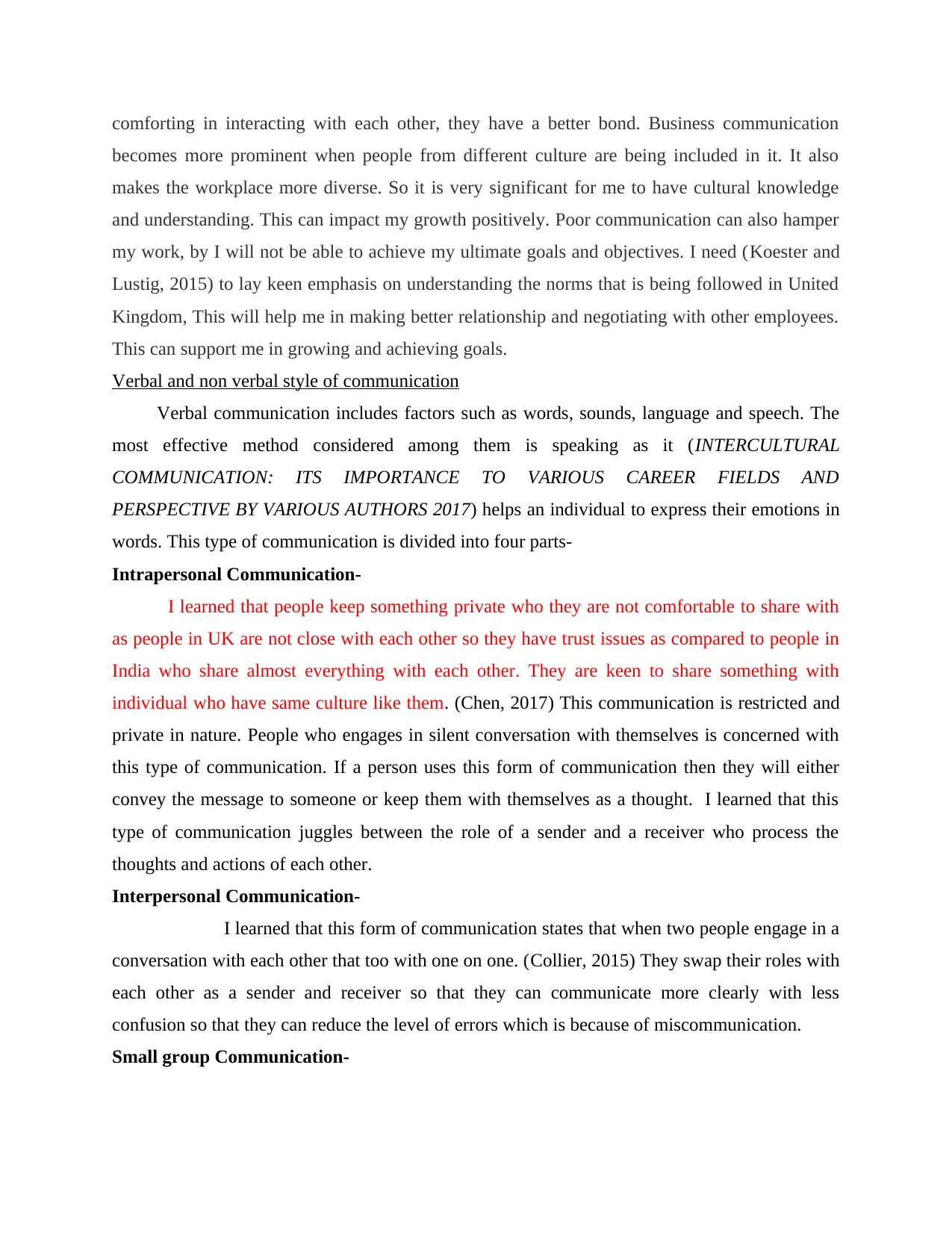
comforting in interacting with each other, they have a better bond. Business communication
becomes more prominent when people from different culture are being included in it. It also
makes the workplace more diverse. So it is very significant for me to have cultural knowledge
and understanding. This can impact my growth positively. Poor communication can also hamper
my work, by I will not be able to achieve my ultimate goals and objectives. I need (Koester and
Lustig, 2015) to lay keen emphasis on understanding the norms that is being followed in United
Kingdom, This will help me in making better relationship and negotiating with other employees.
This can support me in growing and achieving goals.
Verbal and non verbal style of communication
Verbal communication includes factors such as words, sounds, language and speech. The
most effective method considered among them is speaking as it (INTERCULTURAL
COMMUNICATION: ITS IMPORTANCE TO VARIOUS CAREER FIELDS AND
PERSPECTIVE BY VARIOUS AUTHORS 2017) helps an individual to express their emotions in
words. This type of communication is divided into four parts-
Intrapersonal Communication-
I learned that people keep something private who they are not comfortable to share with
as people in UK are not close with each other so they have trust issues as compared to people in
India who share almost everything with each other. They are keen to share something with
individual who have same culture like them. (Chen, 2017) This communication is restricted and
private in nature. People who engages in silent conversation with themselves is concerned with
this type of communication. If a person uses this form of communication then they will either
convey the message to someone or keep them with themselves as a thought. I learned that this
type of communication juggles between the role of a sender and a receiver who process the
thoughts and actions of each other.
Interpersonal Communication-
I learned that this form of communication states that when two people engage in a
conversation with each other that too with one on one. (Collier, 2015) They swap their roles with
each other as a sender and receiver so that they can communicate more clearly with less
confusion so that they can reduce the level of errors which is because of miscommunication.
Small group Communication-
becomes more prominent when people from different culture are being included in it. It also
makes the workplace more diverse. So it is very significant for me to have cultural knowledge
and understanding. This can impact my growth positively. Poor communication can also hamper
my work, by I will not be able to achieve my ultimate goals and objectives. I need (Koester and
Lustig, 2015) to lay keen emphasis on understanding the norms that is being followed in United
Kingdom, This will help me in making better relationship and negotiating with other employees.
This can support me in growing and achieving goals.
Verbal and non verbal style of communication
Verbal communication includes factors such as words, sounds, language and speech. The
most effective method considered among them is speaking as it (INTERCULTURAL
COMMUNICATION: ITS IMPORTANCE TO VARIOUS CAREER FIELDS AND
PERSPECTIVE BY VARIOUS AUTHORS 2017) helps an individual to express their emotions in
words. This type of communication is divided into four parts-
Intrapersonal Communication-
I learned that people keep something private who they are not comfortable to share with
as people in UK are not close with each other so they have trust issues as compared to people in
India who share almost everything with each other. They are keen to share something with
individual who have same culture like them. (Chen, 2017) This communication is restricted and
private in nature. People who engages in silent conversation with themselves is concerned with
this type of communication. If a person uses this form of communication then they will either
convey the message to someone or keep them with themselves as a thought. I learned that this
type of communication juggles between the role of a sender and a receiver who process the
thoughts and actions of each other.
Interpersonal Communication-
I learned that this form of communication states that when two people engage in a
conversation with each other that too with one on one. (Collier, 2015) They swap their roles with
each other as a sender and receiver so that they can communicate more clearly with less
confusion so that they can reduce the level of errors which is because of miscommunication.
Small group Communication-
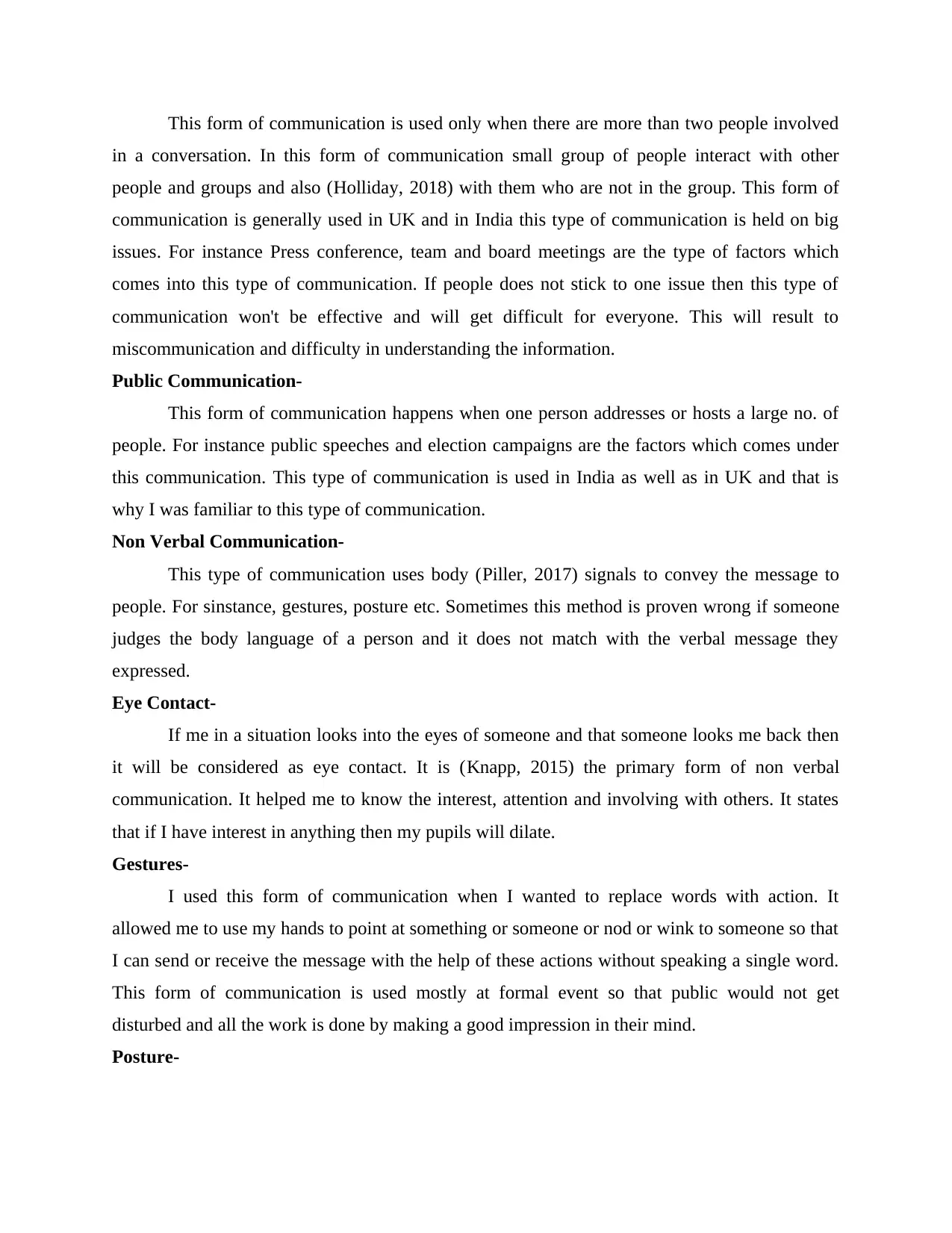
This form of communication is used only when there are more than two people involved
in a conversation. In this form of communication small group of people interact with other
people and groups and also (Holliday, 2018) with them who are not in the group. This form of
communication is generally used in UK and in India this type of communication is held on big
issues. For instance Press conference, team and board meetings are the type of factors which
comes into this type of communication. If people does not stick to one issue then this type of
communication won't be effective and will get difficult for everyone. This will result to
miscommunication and difficulty in understanding the information.
Public Communication-
This form of communication happens when one person addresses or hosts a large no. of
people. For instance public speeches and election campaigns are the factors which comes under
this communication. This type of communication is used in India as well as in UK and that is
why I was familiar to this type of communication.
Non Verbal Communication-
This type of communication uses body (Piller, 2017) signals to convey the message to
people. For sinstance, gestures, posture etc. Sometimes this method is proven wrong if someone
judges the body language of a person and it does not match with the verbal message they
expressed.
Eye Contact-
If me in a situation looks into the eyes of someone and that someone looks me back then
it will be considered as eye contact. It is (Knapp, 2015) the primary form of non verbal
communication. It helped me to know the interest, attention and involving with others. It states
that if I have interest in anything then my pupils will dilate.
Gestures-
I used this form of communication when I wanted to replace words with action. It
allowed me to use my hands to point at something or someone or nod or wink to someone so that
I can send or receive the message with the help of these actions without speaking a single word.
This form of communication is used mostly at formal event so that public would not get
disturbed and all the work is done by making a good impression in their mind.
Posture-
in a conversation. In this form of communication small group of people interact with other
people and groups and also (Holliday, 2018) with them who are not in the group. This form of
communication is generally used in UK and in India this type of communication is held on big
issues. For instance Press conference, team and board meetings are the type of factors which
comes into this type of communication. If people does not stick to one issue then this type of
communication won't be effective and will get difficult for everyone. This will result to
miscommunication and difficulty in understanding the information.
Public Communication-
This form of communication happens when one person addresses or hosts a large no. of
people. For instance public speeches and election campaigns are the factors which comes under
this communication. This type of communication is used in India as well as in UK and that is
why I was familiar to this type of communication.
Non Verbal Communication-
This type of communication uses body (Piller, 2017) signals to convey the message to
people. For sinstance, gestures, posture etc. Sometimes this method is proven wrong if someone
judges the body language of a person and it does not match with the verbal message they
expressed.
Eye Contact-
If me in a situation looks into the eyes of someone and that someone looks me back then
it will be considered as eye contact. It is (Knapp, 2015) the primary form of non verbal
communication. It helped me to know the interest, attention and involving with others. It states
that if I have interest in anything then my pupils will dilate.
Gestures-
I used this form of communication when I wanted to replace words with action. It
allowed me to use my hands to point at something or someone or nod or wink to someone so that
I can send or receive the message with the help of these actions without speaking a single word.
This form of communication is used mostly at formal event so that public would not get
disturbed and all the work is done by making a good impression in their mind.
Posture-
⊘ This is a preview!⊘
Do you want full access?
Subscribe today to unlock all pages.

Trusted by 1+ million students worldwide
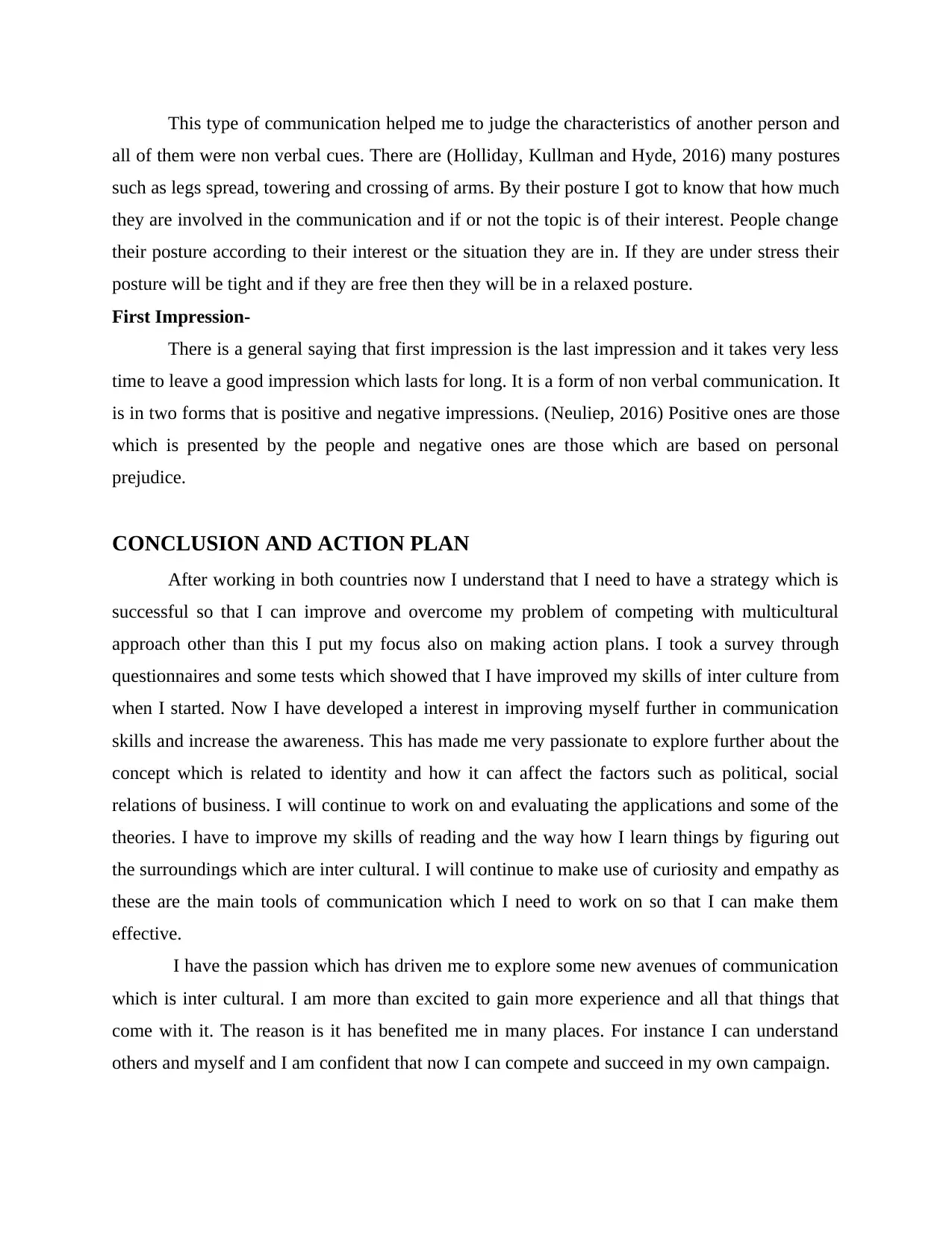
This type of communication helped me to judge the characteristics of another person and
all of them were non verbal cues. There are (Holliday, Kullman and Hyde, 2016) many postures
such as legs spread, towering and crossing of arms. By their posture I got to know that how much
they are involved in the communication and if or not the topic is of their interest. People change
their posture according to their interest or the situation they are in. If they are under stress their
posture will be tight and if they are free then they will be in a relaxed posture.
First Impression-
There is a general saying that first impression is the last impression and it takes very less
time to leave a good impression which lasts for long. It is a form of non verbal communication. It
is in two forms that is positive and negative impressions. (Neuliep, 2016) Positive ones are those
which is presented by the people and negative ones are those which are based on personal
prejudice.
CONCLUSION AND ACTION PLAN
After working in both countries now I understand that I need to have a strategy which is
successful so that I can improve and overcome my problem of competing with multicultural
approach other than this I put my focus also on making action plans. I took a survey through
questionnaires and some tests which showed that I have improved my skills of inter culture from
when I started. Now I have developed a interest in improving myself further in communication
skills and increase the awareness. This has made me very passionate to explore further about the
concept which is related to identity and how it can affect the factors such as political, social
relations of business. I will continue to work on and evaluating the applications and some of the
theories. I have to improve my skills of reading and the way how I learn things by figuring out
the surroundings which are inter cultural. I will continue to make use of curiosity and empathy as
these are the main tools of communication which I need to work on so that I can make them
effective.
I have the passion which has driven me to explore some new avenues of communication
which is inter cultural. I am more than excited to gain more experience and all that things that
come with it. The reason is it has benefited me in many places. For instance I can understand
others and myself and I am confident that now I can compete and succeed in my own campaign.
all of them were non verbal cues. There are (Holliday, Kullman and Hyde, 2016) many postures
such as legs spread, towering and crossing of arms. By their posture I got to know that how much
they are involved in the communication and if or not the topic is of their interest. People change
their posture according to their interest or the situation they are in. If they are under stress their
posture will be tight and if they are free then they will be in a relaxed posture.
First Impression-
There is a general saying that first impression is the last impression and it takes very less
time to leave a good impression which lasts for long. It is a form of non verbal communication. It
is in two forms that is positive and negative impressions. (Neuliep, 2016) Positive ones are those
which is presented by the people and negative ones are those which are based on personal
prejudice.
CONCLUSION AND ACTION PLAN
After working in both countries now I understand that I need to have a strategy which is
successful so that I can improve and overcome my problem of competing with multicultural
approach other than this I put my focus also on making action plans. I took a survey through
questionnaires and some tests which showed that I have improved my skills of inter culture from
when I started. Now I have developed a interest in improving myself further in communication
skills and increase the awareness. This has made me very passionate to explore further about the
concept which is related to identity and how it can affect the factors such as political, social
relations of business. I will continue to work on and evaluating the applications and some of the
theories. I have to improve my skills of reading and the way how I learn things by figuring out
the surroundings which are inter cultural. I will continue to make use of curiosity and empathy as
these are the main tools of communication which I need to work on so that I can make them
effective.
I have the passion which has driven me to explore some new avenues of communication
which is inter cultural. I am more than excited to gain more experience and all that things that
come with it. The reason is it has benefited me in many places. For instance I can understand
others and myself and I am confident that now I can compete and succeed in my own campaign.
Paraphrase This Document
Need a fresh take? Get an instant paraphrase of this document with our AI Paraphraser
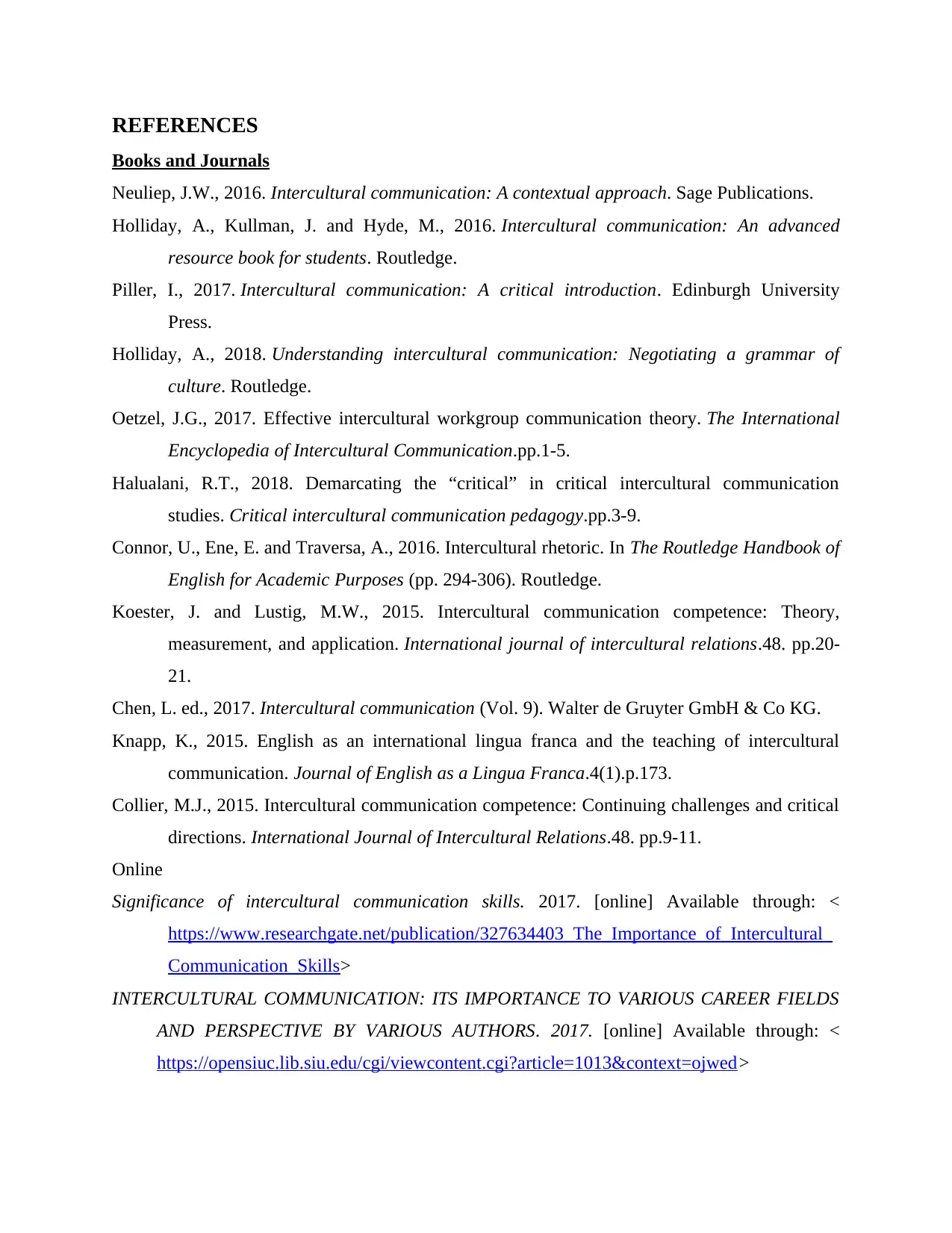
REFERENCES
Books and Journals
Neuliep, J.W., 2016. Intercultural communication: A contextual approach. Sage Publications.
Holliday, A., Kullman, J. and Hyde, M., 2016. Intercultural communication: An advanced
resource book for students. Routledge.
Piller, I., 2017. Intercultural communication: A critical introduction. Edinburgh University
Press.
Holliday, A., 2018. Understanding intercultural communication: Negotiating a grammar of
culture. Routledge.
Oetzel, J.G., 2017. Effective intercultural workgroup communication theory. The International
Encyclopedia of Intercultural Communication.pp.1-5.
Halualani, R.T., 2018. Demarcating the “critical” in critical intercultural communication
studies. Critical intercultural communication pedagogy.pp.3-9.
Connor, U., Ene, E. and Traversa, A., 2016. Intercultural rhetoric. In The Routledge Handbook of
English for Academic Purposes (pp. 294-306). Routledge.
Koester, J. and Lustig, M.W., 2015. Intercultural communication competence: Theory,
measurement, and application. International journal of intercultural relations.48. pp.20-
21.
Chen, L. ed., 2017. Intercultural communication (Vol. 9). Walter de Gruyter GmbH & Co KG.
Knapp, K., 2015. English as an international lingua franca and the teaching of intercultural
communication. Journal of English as a Lingua Franca.4(1).p.173.
Collier, M.J., 2015. Intercultural communication competence: Continuing challenges and critical
directions. International Journal of Intercultural Relations.48. pp.9-11.
Online
Significance of intercultural communication skills. 2017. [online] Available through: <
https://www.researchgate.net/publication/327634403_The_Importance_of_Intercultural_
Communication_Skills>
INTERCULTURAL COMMUNICATION: ITS IMPORTANCE TO VARIOUS CAREER FIELDS
AND PERSPECTIVE BY VARIOUS AUTHORS. 2017. [online] Available through: <
https://opensiuc.lib.siu.edu/cgi/viewcontent.cgi?article=1013&context=ojwed>
Books and Journals
Neuliep, J.W., 2016. Intercultural communication: A contextual approach. Sage Publications.
Holliday, A., Kullman, J. and Hyde, M., 2016. Intercultural communication: An advanced
resource book for students. Routledge.
Piller, I., 2017. Intercultural communication: A critical introduction. Edinburgh University
Press.
Holliday, A., 2018. Understanding intercultural communication: Negotiating a grammar of
culture. Routledge.
Oetzel, J.G., 2017. Effective intercultural workgroup communication theory. The International
Encyclopedia of Intercultural Communication.pp.1-5.
Halualani, R.T., 2018. Demarcating the “critical” in critical intercultural communication
studies. Critical intercultural communication pedagogy.pp.3-9.
Connor, U., Ene, E. and Traversa, A., 2016. Intercultural rhetoric. In The Routledge Handbook of
English for Academic Purposes (pp. 294-306). Routledge.
Koester, J. and Lustig, M.W., 2015. Intercultural communication competence: Theory,
measurement, and application. International journal of intercultural relations.48. pp.20-
21.
Chen, L. ed., 2017. Intercultural communication (Vol. 9). Walter de Gruyter GmbH & Co KG.
Knapp, K., 2015. English as an international lingua franca and the teaching of intercultural
communication. Journal of English as a Lingua Franca.4(1).p.173.
Collier, M.J., 2015. Intercultural communication competence: Continuing challenges and critical
directions. International Journal of Intercultural Relations.48. pp.9-11.
Online
Significance of intercultural communication skills. 2017. [online] Available through: <
https://www.researchgate.net/publication/327634403_The_Importance_of_Intercultural_
Communication_Skills>
INTERCULTURAL COMMUNICATION: ITS IMPORTANCE TO VARIOUS CAREER FIELDS
AND PERSPECTIVE BY VARIOUS AUTHORS. 2017. [online] Available through: <
https://opensiuc.lib.siu.edu/cgi/viewcontent.cgi?article=1013&context=ojwed>

APPENDIX
<https://www.londonschool.com/lsic/resources/intercultural-quiz/>
<https://www.londonschool.com/lsic/resources/intercultural-quiz/>
⊘ This is a preview!⊘
Do you want full access?
Subscribe today to unlock all pages.

Trusted by 1+ million students worldwide
1 out of 9
Related Documents
Your All-in-One AI-Powered Toolkit for Academic Success.
+13062052269
info@desklib.com
Available 24*7 on WhatsApp / Email
![[object Object]](/_next/static/media/star-bottom.7253800d.svg)
Unlock your academic potential
Copyright © 2020–2025 A2Z Services. All Rights Reserved. Developed and managed by ZUCOL.





